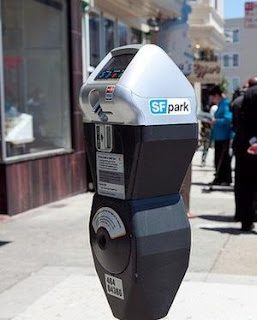Markets in Everything: Smart Parking Meters with 'Demand-Responsive Pricing'
"San Francisco has been working on making parking "smarter" for quite a while now, and it's just recently taken another big step in that direction by starting to replace over 5,000 older parking meters with the snazzy new model pictured above. Those will not only let you pay with a credit or debit card, but will automatically adjust parking rates based on supply and demand, which means you could pay anywhere from $0.25 to $6.00 an hour depending on how many free spaces there are. Those rates are determined with the aid of some sensors that keep a constant watch on parking spaces, which also means you'll be able to check for free spaces in an area on your phone or your computer before you even leave the house."
Link.


5 Comments:
as a SF resident who is familiar with this project and how it came to be, i can pretty definitively tell you that this is not, in fact, about congestion pricing and rather about jacking up revenue.
SF uses parking meters to cover muni transit budget shortfalls. the result has been extremely rapid parking cost increases. my old neighborhood's meters were 15 minutes for 25 cents in 2000. by 2006, they were 3 minutes for 25 cents. ($1/hr goes to $5/hr)
such massive increases have necessitated smart cards etc for parking as no one carries that many quarters.
this new set of meters (apart from being another sweetheart nepotistic deal) makes it even easier to do things like change hours of operation and price all while taking credit cards to further mask costs and allow large payments.
perhaps the biggest revenue generator about them is their "empty space sensor". ostensibly, it's to help you find parking. what it's really for is to take any extra time off the meter when you pull out, allowing the city to sell the same 15 minute multiple times.
the only "responsiveness" in this pricing is responsiveness to muni deficits.
there has been (nor is there planned) and effort to educate hayes valley parkers on the rates and how they shift. this sort of think only shapes traffic if people know how it works.
this is just a revenue maximization scheme.
oh, and let's pretend for a minute that A. a space i see on my PC will still be there in 15 minutes when i arrive or B. that the data from these meters will be broadcast to cell phones rapidly enough that by the time i see it, someone circling the block won't have taken it.
in peak hours hayes valley, there's generally someone waiting for the space before the person leaving has even finished pulling out.
this whole "find a space" feature is useless.
Knowing SF and it's "pick the pockets of visitors" attitude, you might find a metered spot indicating a $0.25 rate spot and find it change to $6.00 the minute you disappear around the corner.
Of course, I'm only guessing about the thought process of the left-of-left government officials in S.F. - but I find it odd that they have no problem charging more for something because of decreasing availability...even calling it "smart". But if you're parking in front of a private business that's charging more, due to a run on a certain product, it's called "price gouging".
"But if you're parking in front of a private business that's charging more, due to a run on a certain product, it's called "price gouging"."
==================================
Priceless.
If this works, charging enough for limited parking space will simply cause people to go elsewhere. That is certain to reduce the amount of traffic. That is to say reduce the traffic in the area of high price meters, but increase it overall as people search elsewhere for more convenience and lower cost.
This is a double whammy, since planners who want to reduce traffic do it by planning for insufficient parking to begin with. This gives a machiavellian excuse for smart meters, which will undoubtedly cause people and businesses to locate someplace else.
And all of this is in the name of reducing sprawl and making neighborhoods more pedestrian friendly.
There is probably some optimum mix of job density, residential density, and street density that produces the lowest overall cost for maintenance of structures, and infrastructure, and travel.
Undoubtedly it depends on the cost of energy and cost of labor, so it changes over time, and changes faster than we can change our urban environments to match the cost inputs.
Post a Comment
<< Home